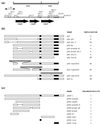Structural elements required for replication and incompatibility of the Rhizobium etli symbiotic plasmid
- PMID: 10809690
- PMCID: PMC94497
- DOI: 10.1128/JB.182.11.3117-3124.2000
Structural elements required for replication and incompatibility of the Rhizobium etli symbiotic plasmid
Abstract
The symbiotic plasmid of Rhizobium etli CE3 belongs to the RepABC family of plasmid replicons. This family is characterized by the presence of three conserved genes, repA, repB, and repC, encoded by the same DNA strand. A long intergenic sequence (igs) between repB and repC is also conserved in all members of the plasmid family. In this paper we demonstrate that (i) the repABC genes are organized in an operon; (ii) the RepC product is essential for replication; (iii) RepA and RepB products participate in plasmid segregation and in the regulation of plasmid copy number; (iv) there are two cis-acting incompatibility regions, one located in the igs (incalpha) and the other downstream of repC (incbeta) (the former is essential for replication); and (v) RepA is a trans-acting incompatibility factor. We suggest that incalpha is a cis-acting site required for plasmid partitioning and that the origin of replication lies within incbeta.
Figures



Similar articles
-
The replication origin of a repABC plasmid.BMC Microbiol. 2011 Jun 30;11:158. doi: 10.1186/1471-2180-11-158. BMC Microbiol. 2011. PMID: 21718544 Free PMC article.
-
Incompatibility and the partitioning site of the repABC basic replicon of the symbiotic plasmid from Rhizobium etli.Plasmid. 2004 May;51(3):203-16. doi: 10.1016/j.plasmid.2004.01.005. Plasmid. 2004. PMID: 15109827
-
RepA negatively autoregulates the transcription of the repABC operon of the Rhizobium etli symbiotic plasmid basic replicon.Mol Microbiol. 2001 Oct;42(1):195-204. doi: 10.1046/j.1365-2958.2001.02621.x. Mol Microbiol. 2001. PMID: 11679078
-
The repABC plasmid family.Plasmid. 2008 Jul;60(1):19-37. doi: 10.1016/j.plasmid.2008.03.001. Epub 2008 Apr 22. Plasmid. 2008. PMID: 18433868 Review.
-
The ABCs of plasmid replication and segregation.Nat Rev Microbiol. 2012 Nov;10(11):755-65. doi: 10.1038/nrmicro2882. Nat Rev Microbiol. 2012. PMID: 23070556 Review.
Cited by
-
Sequence analysis of the 144-kilobase accessory plasmid pSmeSM11a, isolated from a dominant Sinorhizobium meliloti strain identified during a long-term field release experiment.Appl Environ Microbiol. 2006 May;72(5):3662-72. doi: 10.1128/AEM.72.5.3662-3672.2006. Appl Environ Microbiol. 2006. PMID: 16672515 Free PMC article.
-
Identification of the partitioning site within the repABC-type replicon of the composite Paracoccus versutus plasmid pTAV1.J Bacteriol. 2001 Nov;183(21):6234-43. doi: 10.1128/JB.183.21.6234-6243.2001. J Bacteriol. 2001. PMID: 11591666 Free PMC article.
-
The replication origin of a repABC plasmid.BMC Microbiol. 2011 Jun 30;11:158. doi: 10.1186/1471-2180-11-158. BMC Microbiol. 2011. PMID: 21718544 Free PMC article.
-
A Minimal Genetic Passkey to Unlock Many Legume Doors to Root Nodulation by Rhizobia.Genes (Basel). 2020 May 7;11(5):521. doi: 10.3390/genes11050521. Genes (Basel). 2020. PMID: 32392829 Free PMC article.
-
Sequence of the 165-kilobase catabolic plasmid pAO1 from Arthrobacter nicotinovorans and identification of a pAO1-dependent nicotine uptake system.J Bacteriol. 2003 Mar;185(6):1976-86. doi: 10.1128/JB.185.6.1976-1986.2003. J Bacteriol. 2003. PMID: 12618462 Free PMC article.
References
-
- Abeles A L, Fredman S A, Austin S J. Partition of unit-copy miniplasmid to daughter cells. III. The DNA sequence and functional organization of the P1 partition region. J Mol Biol. 1985;185:261–272. - PubMed
-
- Alexeyev M F, Shokolenko I N, Croughan T P. Improved antibiotic-resistance gene cassettes and omega elements for Escherichia coli vector construction and in vitro deletion insertion mutagenesis. Gene. 1995;160:63–67. - PubMed
-
- Austin S, Abeles A. Partition of unit-copy miniplasmid to daughter cells. II. The partition region of miniplasmid P1 encodes an essential protein and a centromere-like site at which it acts. J Mol Biol. 1983;169:373–387. - PubMed
-
- Bartosik D, Baj J, Wlodarczyk M. Molecular and functional analysis of pTAV320, a repABC-type replicon of the Paracoccus versutus composite plasmid pTAV1. Microbiology. 1998;144:3149–3157. - PubMed
-
- Beynon J L, Beringer J E, Johnston A W B. Plasmid and host range in Rhizobium leguminosarum and Rhizobium phaseoli. J Gen Microbiol. 1980;120:421–429.
Publication types
MeSH terms
Substances
LinkOut - more resources
Full Text Sources

